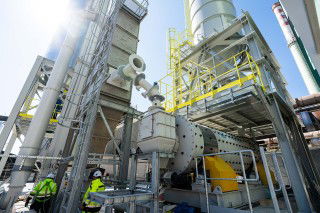Egypt's cement sector has been battling against the economic tide for a considerable time as overcapacity, the end of energy subsidies and low cement demand has pushed some producers to the edge of existence, while others have become too debt-ridden to survive. However, this week saw better news as the country is launching a significant infrastructure drive and prices of construction materials have risen. Is it this simple to fix Egypt's long-suffering cement sector?
It will take a prolonged upturn in the economic situation for Egypt's cement producers to start feeling comfortable again. The price war has seen cement prices plummet and industry analysts estimate the sector has lost more than EGP1bn (US$63.6m). Cement prices have seen a rise in 2021, increasing by 20 per cent between January and August to EGP900/t (US$57.2). However, even now cement prices are still some 33 per cent below what was achievable before the capacity glut.
1H21 losses start to shrink
The 1H21 witnessed improved results for several Egyptian cement producers. Misr Cement (Qena) led the way by recording a 9.2 per cent YoY advance in consolidated net profit over the period while Sinai Cement (Vicat group) also saw its net losses reduce compared to the 1H20. However, Arabian Cement fell behind further, widening its net loss in the first half of 2021.
Improving factors
Inflationary pressures on margins with higher fuel costs, electricity prices and raw material costs have trigged much of the cement price increase. Most Egyptian cement plants (16 out of 18) still use coal as part of their operations and have had to pass the cost on to customers, with coal hitting a 13-year high at US$170/t in August. Producers have been able to pass on some of these costs as cement consumption rose for the first time in five years. The Trade Industry Ministry forecast cement demand increasing by six per cent this year to almost 49Mt.
A return to natural gas
Reducing costs remains a priority to offset inflationary pressures and cement producers are looking at returning to natural gas instead of coal, seven years after the government encouraged companies to use a mixture of coal and alternative fuels. The price of natural gas was reduced for the industry to US$4.50/mBtu from March 2020, prompting the Export Council for Building Materials to prepare technical studies on the feasibility of cement factories returning to natural gas.
Current industry position
While there are several favourable economic factors lining up behind higher cement prices, the sector is far from making a fresh start. The country has a total cement capacity of 91.9Mta but is still several million tonnes short of the consumption peak of 56.6Mt seen in 2016. July's government regulation cut of 10 per cent of production has eased oversupply and bolstered cement prices. However, Lafarge Egypt CEO, Solomon Baumgartner, says cement prices need to rise by another 30-35 per cent by the middle of October. Lafarge has been losing about 20 per cent of its sales in volume terms due to the quotas.
Infrastructure boom
Getting the industry back on its feet will require higher cement demand and there are reasons to be optimistic. An infrastructure boom will provide the stimulus to push Egyptian cement demand back up to higher levels. Projects in the pipeline include a EGP4.5bn high-speed rail contract from Cairo to Aswan and Luxor to Hurghada. French state-guaranteed loans, agreed in June, will also see upgrades to the Cairo Metro, a rail line to Sudan, and water and energy schemes. Further cement demand is expected to come from Egypt’s new smart capital, an administrative hub, costing US$45-58bn and situated 21 miles east of Cairo, that will house more than 6.5m residents and include a new international airport.
No quick fix
Egypt's cement producers have felt the benefit of several economic factors that have improved cement prices in the 1H21. However, they will need continued support from improved cement demand in the medium- to long-term to really turn around their balance sheets. Fuel costs, raw materials costs and electricity prices are not likely to fall any time soon, so the industry will hope for further large-scale construction projects to keep them ahead of the rising cost curve.
